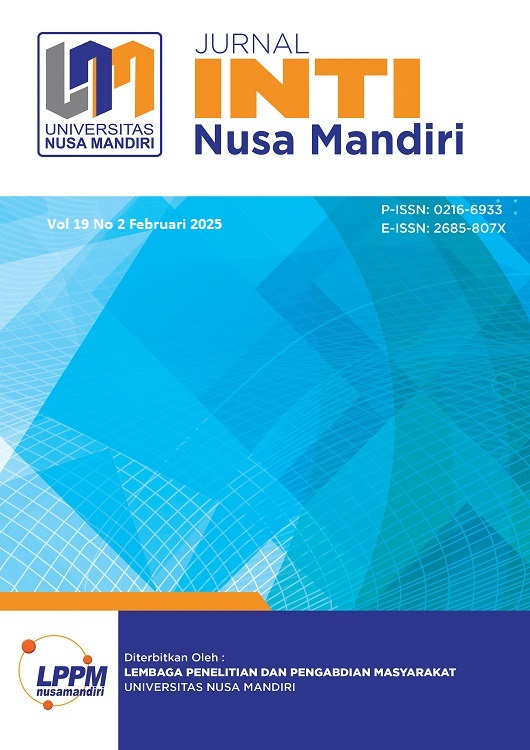IMPLEMENTASI MODEL DeiT UNTUK MEMBEDAKAN GAMBAR BUATAN AI DAN MANUSIA PADA ILUSTRASI ANIMASI 2D
DOI:
https://doi.org/10.33480/inti.v19i2.6306Kata Kunci:
artificial intelligence, deit, image classification, transformers, 2D animationAbstrak
The development of artificial intelligence (AI) has influenced various fields, including art and visual design. AI Generative Art, which mimics human styles, has sparked debates on originality, artistic value, as well as legal and ethical challenges. Therefore, methods are needed to distinguish between AI-generated and human-made images, particularly in 2D animation illustrations. This study proposes the use of Data-efficient Image Transformers (DeiT) for image classification. Two models tested are DeiT Base and DeiT Tiny, using a dataset of 6,000 images equally divided between AI and human categories. The dataset is split into training (70%), validation (15%), and testing (15%). Experimental results show that DeiT Base achieves over 95% accuracy with fast convergence and optimal loss function stability. Meanwhile, DeiT Tiny attains around 93% accuracy, being more computationally efficient despite requiring more epochs for stability. Compared to previous models using a larger dataset (11,000 images per category) but achieving only 80% accuracy, DeiT performs better in both accuracy and computational efficiency, even with a smaller dataset. In conclusion, DeiT is effective for classifying 2D animation images. DeiT Base excels in accuracy and convergence speed, while DeiT Tiny is more resource-efficient, making it an ideal choice for environments with computational constraints.
Unduhan
Referensi
Amankwah-Amoah, J., Abdalla, S., Mogaji, E., Elbanna, A., & Dwivedi, Y. K. (2024). The impending disruption of creative industries by generative AI: Opportunities, challenges, and research agenda. International Journal of Information Management, Vol. 79. https://doi.org/10.1016/j.ijinfomgt.2024.102759
Bbouzidi, S., Hcini, G., Jdey, I., & Drira, F. (2024). Convolutional Neural Networks and Vision Transformers for Fashion MNIST Classification: A Literature Review. Retrieved from https://arxiv.org/abs/2406.03478
Bellaiche, L., Shahi, R., Turpin, M. H., Ragnhildstveit, A., Sprockett, S., Barr, N., … Seli, P. (2023). Humans versus AI: whether and why we prefer human-created compared to AI-created artwork. Cognitive Research: Principles and Implications, 8(1). https://doi.org/10.1186/s41235-023-00499-6
Dosovitskiy, A., Beyer, L., Kolesnikov, A., Weissenborn, D., Zhai, X., Unterthiner, T., … Houlsby, N. (2021). AN IMAGE IS WORTH 16X16 WORDS: TRANSFORMERS FOR IMAGE RECOGNITION AT SCALE. ICLR 2021 - 9th International Conference on Learning Representations.
Giorgetti, I. (2024). Exploring the Intersection of Art, Human Creativity, and AI. Itinera. https://doi.org/10.54103/2039-9251/27841
Ha, A. Y. J., Passananti, J., Bhaskar, R., Shan, S., Southen, R., Zheng, H., & Zhao, B. Y. (2024). Organic or Diffused: Can We Distinguish Human Art from AI-generated Images? Proceedings of the 2024 on ACM SIGSAC Conference on Computer and Communications Security, 4822–4836. New York, NY, USA: Association for Computing Machinery. https://doi.org/10.1145/3658644.3670306
Huang, Z., Xie, H., Fukusato, T., & Miyata, K. (2023). AniFaceDrawing: Anime Portrait Exploration during Your Sketching. Proceedings - SIGGRAPH 2023 Conference Papers. https://doi.org/10.1145/3588432.3591548
Kang, K., Setlur, A., Ghosh, D., Steinhardt, J., Tomlin, C., Levine, S., & Kumar, A. (2024). What Do Learning Dynamics Reveal About Generalization in LLM Reasoning? Retrieved from https://arxiv.org/abs/2411.07681
Khan, F. F., Kim, D., Jha, D., Mohamed, Y., Chang, H. H., Elgammal, A., … Elhoseiny, M. (2024). AI Art Neural Constellation: Revealing the Collective and Contrastive State of AI-Generated and Human Art. 2024 IEEE/CVF Conference on Computer Vision and Pattern Recognition Workshops (CVPRW), 7470–7478. https://doi.org/10.1109/CVPRW63382.2024.00742
Li, B., Zhu, Y., Wang, Y., Lin, C. W., Ghanem, B., & Shen, L. (2022). AniGAN: Style-Guided Generative Adversarial Networks for Unsupervised Anime Face Generation. IEEE Transactions on Multimedia, 24. https://doi.org/10.1109/TMM.2021.3113786
Maleki, F., Muthukrishnan, N., Ovens, K., Md, C., & Forghani, R. (2020). Machine Learning Algorithm Validation. Neuroimaging Clinics of North America, 30, 433–445. https://doi.org/10.1016/j.nic.2020.08.004
Prawiratama, R. A., Sumarno, & Kautsar, I. A. (2024). RANCANG BANGUN APLIKASI UJI KEMIRIPAN GAMBAR AI GENERATIVE DAN GAMBAR BUATAN TANGAN MENGGUNAKAN METODE DEEP LEARNING. TEKINKOM. Retrieved from https://jurnal.murnisadar.ac.id/index.php/Tekinkom/article/view/1192/599
Safebooru. (2024). Safebooru / original.
Samo, A., & Highhouse, S. (2023). Artificial Intelligence and Art: Identifying the Aesthetic Judgment Factors That Distinguish Human and Machine-Generated Artwork. Psychology of Aesthetics, Creativity, and the Arts. https://doi.org/10.1037/aca0000570
Touvron, H., Cord, M., Douze, M., Massa, F., Sablayrolles, A., & Jégou, H. (2021). Training data-efficient image transformers & distillation through attention. International Conference on Machine Learning, 10347–10357.
Vyas, B. (2022). Ethical Implications of Generative AI in Art and the Media. International Journal For Multidisciplinary Research, 4, 1–11.
ZeroChan. (2024a). NovelAI - AI Art - ZeroChan Anime Image Board.
ZeroChan. (2024b). Official Art - ZeroChan Anime Image Board.
ZeroChan. (2024c). StableDiffusion - AI Art - ZeroChan Anime Image Board.
##submission.downloads##
Diterbitkan
Cara Mengutip
Terbitan
Bagian
Lisensi
Hak Cipta (c) 2025 Ibnu Taimiyah Erwin, Abdul Latief Arda, Imran Taufik, Muhammad Erwin Rosyadi. S, Hilyatul Auliyah Erwin

Artikel ini berlisensi Creative Commons Attribution-NonCommercial 4.0 International License.
Penulis yang menerbitkan jurnal ini menyetujui ketentuan berikut:
1. Penulis memegang hak cipta dan memberikan hak jurnal mengenai publikasi pertama dengan karya yang dilisensikan secara bersamaan di bawah Creative Commons Attribution 4.0 International License. yang memungkinkan orang lain untuk berbagi karya dengan pengakuan atas karya penulis dan publikasi awal pada jurnal.
2. Penulis dapat memasukkan pengaturan kontrak tambahan yang terpisah untuk distribusi non-eksklusif dari versi jurnal yang diterbitkan (misalnya, mengirimkannya ke repositori institusional atau menerbitkannya dalam sebuah buku), dengan pengakuan atas publikasi awalnya pada Jurnal.
3. Penulis diizinkan dan didorong untuk memposting karya mereka secara online (misalnya, dalam penyimpanan institusional atau di situs web mereka) sebelum dan selama proses pengiriman, karena hal itu dapat menghasilkan pertukaran yang produktif, serta kutipan dari karya yang diterbitkan sebelumnya.











